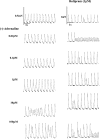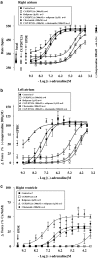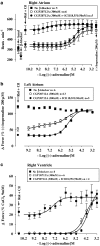Phosphodiesterase-4 blunts inotropism and arrhythmias but not sinoatrial tachycardia of (-)-adrenaline mediated through mouse cardiac beta(1)-adrenoceptors
- PMID: 18084319
- PMCID: PMC2259196
- DOI: 10.1038/sj.bjp.0707631
Phosphodiesterase-4 blunts inotropism and arrhythmias but not sinoatrial tachycardia of (-)-adrenaline mediated through mouse cardiac beta(1)-adrenoceptors
Abstract
Background and purpose: beta(1) and beta(2)-adrenoceptors coexist in murine heart but beta(2)-adrenoceptor-mediated effects have not been detected in atrial and ventricular tissues, possibly due to marked phosphodiesterase (PDE) activity. We investigated the influence of the PDE3 inhibitor cilostamide and PDE4 inhibitor rolipram on the effects of (-)-adrenaline in three regions of murine heart.
Experimental approach: (-)-Adrenaline-evoked cardiostimulation was compared on sinoatrial beating rate, left atrial and right ventricular contractile force in isolated tissues from 129SvxC57B1/6 cross mice. Ventricular arrhythmic contractions were also assessed.
Key results: Both rolipram (1 microM) and cilostamide (300 nM) caused transient sinoatrial tachycardia but neither enhanced the chronotropic potency of (-)-adrenaline. Rolipram potentiated 19-fold (left atrium) and 7-fold (right ventricle) the inotropic effects of (-)-adrenaline. (-)-Adrenaline elicited concentration-dependent ventricular arrhythmias that were potentiated by rolipram. All effects of (-)-adrenaline were antagonized by the beta(1)-adrenoceptor-selective antagonist CGP20712A (300 nM). Cilostamide (300 nM) did not increase the chronotropic and inotropic potencies of (-)-adrenaline, but administered jointly with rolipram in the presence of CGP20712A, uncovered left atrial inotropic effects of (-)-adrenaline that were prevented by the beta(2)-adrenoceptor-selective antagonist ICI118551.
Conclusions and implications: PDE4 blunts the beta(1)-adrenoceptor-mediated effects of (-)-adrenaline in left atrium and right ventricle but not in sinoatrial node. Both PDE3 and PDE4 reduce basal sinoatrial rate in a compartment distinct from the beta(1)-adrenoceptor compartment. PDE3 and PDE4, acting in concert, prevent left atrial beta(2)-adrenoceptor-mediated inotropy. PDE4 partially protects the right ventricle against (-)-adrenaline-evoked arrhythmias.
Figures






Similar articles
-
Inotropy and L-type Ca2+ current, activated by beta1- and beta2-adrenoceptors, are differently controlled by phosphodiesterases 3 and 4 in rat heart.Br J Pharmacol. 2009 Jan;156(1):62-83. doi: 10.1111/j.1476-5381.2008.00015.x. Br J Pharmacol. 2009. PMID: 19133992 Free PMC article.
-
Function of cardiac beta1- and beta2-adrenoceptors of newborn piglets: role of phosphodiesterases PDE3 and PDE4.Eur J Pharmacol. 2010 Jul 25;638(1-3):99-107. doi: 10.1016/j.ejphar.2010.04.013. Epub 2010 Apr 18. Eur J Pharmacol. 2010. PMID: 20406625
-
Phosphodiesterases PDE3 and PDE4 jointly control the inotropic effects but not chronotropic effects of (-)-CGP12177 despite PDE4-evoked sinoatrial bradycardia in rat atrium.Naunyn Schmiedebergs Arch Pharmacol. 2009 Apr;379(4):379-84. doi: 10.1007/s00210-008-0367-7. Epub 2008 Nov 14. Naunyn Schmiedebergs Arch Pharmacol. 2009. PMID: 19005642
-
Dual PDE3/4 inhibitors as therapeutic agents for chronic obstructive pulmonary disease.Br J Pharmacol. 2009 Jul;157(6):892-906. doi: 10.1111/j.1476-5381.2009.00170.x. Epub 2009 Jun 5. Br J Pharmacol. 2009. PMID: 19508401 Free PMC article. Review.
-
Pivotal effects of phosphodiesterase inhibitors on myocyte contractility and viability in normal and ischemic hearts.Acta Pharmacol Sin. 2009 Jan;30(1):1-24. doi: 10.1038/aps.2008.1. Epub 2008 Dec 8. Acta Pharmacol Sin. 2009. PMID: 19060915 Free PMC article. Review.
Cited by
-
Levosimendan increases the phosphorylation state of phospholamban in the isolated human atrium.Naunyn Schmiedebergs Arch Pharmacol. 2023 Apr;396(4):669-682. doi: 10.1007/s00210-022-02348-7. Epub 2022 Nov 29. Naunyn Schmiedebergs Arch Pharmacol. 2023. PMID: 36445386 Free PMC article.
-
PKA-independent activation of I(f) by cAMP in mouse sinoatrial myocytes.Channels (Austin). 2013 Jul-Aug;7(4):318-21. doi: 10.4161/chan.25293. Epub 2013 Jun 11. Channels (Austin). 2013. PMID: 23756695 Free PMC article.
-
Cardiac cyclic nucleotide phosphodiesterases: function, regulation, and therapeutic prospects.Horm Metab Res. 2012 Sep;44(10):766-75. doi: 10.1055/s-0032-1321870. Epub 2012 Sep 5. Horm Metab Res. 2012. PMID: 22951903 Free PMC article. Review.
-
Phosphodiesterases and Compartmentation of cAMP and cGMP Signaling in Regulation of Cardiac Contractility in Normal and Failing Hearts.Int J Mol Sci. 2022 Feb 15;23(4):2145. doi: 10.3390/ijms23042145. Int J Mol Sci. 2022. PMID: 35216259 Free PMC article. Review.
-
Phosphodiesterases 3 and 4 Differentially Regulate the Funny Current, If, in Mouse Sinoatrial Node Myocytes.J Cardiovasc Dev Dis. 2017 Sep;4(3):10. doi: 10.3390/jcdd4030010. Epub 2017 Aug 1. J Cardiovasc Dev Dis. 2017. PMID: 28868308 Free PMC article.
References
-
- Brunkhorst D, v der Leysen H, Meyer W, Nigbur R, Schmidt-Schumacher C, Scholz H. Relation of positive inotropic effects of pimobendan, UD-CG212Cl, milrinone and other phosphodiesterase inhibitors to phosphodiesterase III inhibition in guinea-pig heart. Naunyn Schmiedebergs Arch Pharmacol. 1989;339:575–583. - PubMed
-
- Ceylan-Isik AF, LaCour KH, Ren J. Gender disparity of streptozotocin-induced intrinsic contractile dysfunction in murine ventricular myocytes: role of chronic activation of AKT. Clin Exp Pharmacol Physiol. 2006;33:102–108. - PubMed
-
- Christ T, Engel A, Ravens U, Kaumann AJ. Cilostamide potentiates more the positive inotropic effects of (−)-adrenaline through β2-adrenoceptors than the effects of (−)-noradrenaline through β1-adrenoceptors in human atrial myocardium. Naunyn Schmiedebergs Arch Pharmacol. 2006a;374:249–253. - PubMed
-
- Christ T, Molenaar P, Galindo-Tovar A, Ravens U, Kaumann AJ.Contractile responses through Gs-coupled receptors are reduced by phosphodiesterase3 activity in human isolated myocardium Biochemical Society Focusing Meeting. Compartmentalization of Cyclic AMP Signaling 2006bKing's College: Cambridge, UK; 29–30.March: P014
-
- Chruscinski AJ, Rohrer DK, Schauble E, Desai KH, Berstein D, Kobilka BK. Targeted disruption of the β2-adrenergic receptor gene. J Biol Chem. 1999;274:16694–16700. - PubMed
Publication types
MeSH terms
Substances
Grants and funding
LinkOut - more resources
Full Text Sources

